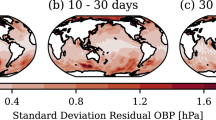Abstract
This paper presents an algorithm for retrieving the oceanic concentrations of optically active materials (OAMs)—phytoplankton, particulate matter, and dissolved organics—from signals of a multispectral sensor placed at an arbitrary height above the sea surface. The algorithm takes into account sensor noises (both photon (shot) and dark current). The joint distribution of the upwelling radiance and OAM spectra required for the algorithm is constructed using optical models of water and the oceanic atmosphere. A method based on correlations between inherent optical properties is proposed to improve the retrieval accuracy. The calculations showed that this method significantly increases the accuracy of OAM retrieval.
Similar content being viewed by others
References
J. E. O’Reilly, S. Maritorena, B. G. Mitchell, et al., “Ocean Color Chlorophyll Algorithms for SeaWiFS,” J. Geophys. Res. 103(C11), 24937–24953 (1998).
S. Sathyendranath, L. Prieur, and A. Morel, “A Three-Component Model of Ocean Colour and Its Application to Remote Sensing of Phytoplankton Pigments in Coastal Waters,” Int. J. Remote Sens. 10(8), 1373–1394 (1989).
Z. Lee and K. L. Carder, “Effect of Spectral Band Numbers on the Retrieval of Water Column and Bottom Properties from Ocean Color Data,” Appl. Opt. 41(12), 2191–2201 (2002).
I. M. Levin, E. I. Levina, G. D. Gil’bert, et al., “Optimal Algorithm for Remote Determination of Optically Active Substances in the Ocean with a Multichannel Spectrometer,” Izv., Atmos. Ocean. Phys. 41(5), 632–640 (2005).
I. M. Levin and E. I. Levina, “Effect of Atmospheric Interference and Sensor Noise in Retrieval of Optically Active Materials in the Ocean by Hyperspectral Remote Sensing,” Appl. Opt. 46(28), 6896–6906 (2007).
V. P. Kozlov, “Problems of Experiment Design with Scope in a Functional Space,” in Mathematical Theory of Experiment Design, Ed. by S. M. Ermakov (Nauka, St. Petersburg, 1983) [in Russian].
V. P. Kozlov, I. M. Levin, and I. V. Zolotukhin, “Optimum Selection of Spectral Channels in the Problem of Remote Sensing of Phytoplankton Concentration in Ocean Water,” in Proceedings of Pacific Ocean Remote Sensing Conference (PORSEC-92), Okinava, Japan, 1992 (Okinava, 1992), pp. 1073–1075.
I. V. Zolotukhin and I. M. Levin, “Optimum Experiment Planning for Remote Determination of the Content of Optically Active Substances in the Ocean,” Dokl. Earth Sci. 355(5), 749–751 (1997).
I. V. Zolotukhin and I. M. Levin, “Application of the Theory of Optimal Experimental Design to Remote Sensing of Phytoplankton and Other Optically Active Substances in the Ocean,” Izv., Atmos. Ocean. Phys. 35(5), 616–624 (1999).
Yu.-A. R. Mullamaa, Atlas of Optical Properties of Sea Surface Waves (Est. Acad. Sci., Tartu, 1964) [in Russian].
I. M. Levin, “On the Coefficient of Sea Radiance: Use of Molecular Scattering,” Okeanologiya 37(2), 192–194 (1997).
L. Prieur and S. Sathyendranath, “An Optical Classification of Coastal and Oceanic Waters based on the Specific Spectral Absorption Curves of Phytoplankton Pigments, Dissolved Organic Matter, and Other Particulate Materials,” Limnol. Oceanogr. 26(4), 671–689 (1981).
A. Morel and S. Maritorena, “Bio-Optical Properties of Oceanic Waters: A Reappraisal,” J. Geophys. Res. 106(C4), 7163–7180 (2001).
A. Morel, “Are the Empirical Relationships Describing the Bio-Optical Properties of Case 1 Waters Consistent and Internally Compatible?,” J. Geophys. Res. 114, C01016 (2009). doi 10.1029/2008JC004803
R. W. Gould, R. A. Arnone, and P. M. Martinolich, “Spectral Dependence of the Scattering Coefficient in Case 1 and Case 2 Waters,” Appl. Opt. 38(12), 2377–2383 (1999).
A. Morel, D. Antoine, and B. Gentili, “Biderectional Reflectance of Oceanic Waters: Accounting for Raman Emission and Varying Particle Scattering Phase Function,” Appl. Opt. 41(30), 6289–6306 (2002).
A. Bricaud, M. Babin, A. Morel, et al., “Variability in the Chlorophyll-Specific Absorption Coefficients of Natural Phytoplankton: Analysis and Parameterization,” J. Geophys. Res. 100(C7), 13321–13332 (1995).
O. V. Kopelevich, “The Current Low-Parametric Models of Seawater Optical Properties,” in Proceedings of International Conference “Current Problems in Optics of Natural Waters” (ONW’2001), St. Petersburg, Russia, 2001 (D.S. Rozhdestvensky Optical Society, St.Petersburg, 2001), pp. 18–23.
R. M. Pope and E. S. Fry, “Absorption Spectrum (380–700 nm) of Pure Water. II. Integrating Cavity Measurements,” Appl. Opt. 36(33), 8710–8723 (1997).
V. V. Sobolev, Radiant Energy Transfer in Stellar and Planetary Atmospheres (Gostekhizdat, Moscow, 1956) [in Russian].
H. R. Gordon and D. J. Castano, “Aerosol Analysis with the Coastal Zone Color Scanner: A Simple Method for Including Multiple Scattering Effects,” Appl. Opt. 28(7), 1320–1326 (1989).
K. S. Shifrin and I. K. Minin, “On the Nonhorizontal Theory of Visibility,” Tr. Gl. Geofiz. Obs. im. A.I. Voeikova 68, 5–75 (1957).
W. W. Gregg and K. L. Carder, “A Simple Spectral Solar Irradiance Model for Cloudless Maritime Atmospheres,” Limnol. Oceanogr. 35(8), 1657–1675 (1990).
K. S. Shifrin, “Optical Properties of the Atmosphere over Oceans,” in Light Scattering and Absorption in Natural and Artificial Disperse Environments (Inst. Phys., Minsk, 1991), pp. 277–288 [in Russian].
O. I. Koblents-Mishke and V. I. Vedernikov, “Primary Product,” in Oceanology. Ocean Biology, Ed. by M. V. Vinogradov (Nauka, Moscow, 1977), Vol. 2, pp. 183–208 [in Russian].
Ocean Optics, Ed. by A. S. Monin (Nauka, Moscow, 1983), Vols. 1–2 [in Russian].
I. M. Levin and O. V. Kopelevich, “Correlations between Inherent Optical Properties in the Near-550 nm Spectral Range,” Okeanologiya 47(3), 344–348 (2008).
I. M. Levin and T. M. Radomyslskaya, “Estimate of Water Inherent Optical Properties from Secchi Depth,” Izv., Atmos. Ocean. Phys. 48(2), 214–221 (2012).
Author information
Authors and Affiliations
Corresponding author
Additional information
Original Russian Text © I.M. Levin, E.I. Levina, 2012, published in Izvestiya AN. Fizika Atmosfery i Okeana, 2012, Vol. 48, No. 5, pp. 608–616.
Rights and permissions
About this article
Cite this article
Levin, I.M., Levina, E.I. Errors in the retrieval of oceanic concentrations of optically active materials from multispectral sensor signals by observations through atmospheric layer. Izv. Atmos. Ocean. Phys. 48, 544–551 (2012). https://doi.org/10.1134/S0001433812050064
Received:
Accepted:
Published:
Issue Date:
DOI: https://doi.org/10.1134/S0001433812050064




